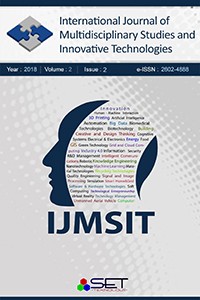Öz
Son yıllarda mini ve mikrokanallarda kaynamalı akış üzerine yapılan çalışmalar, ısı geçişi iyileştirme tekniklerinden biri olan yüzey porozitesi (gözeneklilik) etkisine dikkat çekmektedir. Poroziteli yüzeydeki ısı geçişinin düz bir yüzeye göre üç kat daha fazla olduğunu gösteren çalışmalara rastlanmıştır. Minyatürleşen elektronik cihazlarda oluşan yüksek ısı akılarının bertaraf edilebilmesi için, küçük alanlara yerleştirilebilen genişletilmiş yüzeylere ihtiyaç vardır. Bu noktada poroziteli yüzeyler bu probleme cevap verip vermeyeceği günümüzün araştırma konularından biridir. Bu çalışmada, ısı geçişi uygulamalarında kullanılmak üzere ısı iletimi yüksek olan bakır tozundan sinterleme yöntemiyle poroziteli yüzeyler elde edilmesi amaçlanmıştır. Farklı firmalardan alınan değişik boyuta sahip bakır tozlarının karakterizasyonlarını belirlemek için çeşitli analiz yöntemleri uygulanmıştır. Bu yöntemler; tane boyutu için, taramalı elektron mikroskobunda görüntü analizi (SEM), saflık testi için EDS ve bakır tozunun ergime sıcaklığını belirlemek için ise termal analiz olarak belirlenmiştir. Yapılan deneysel çalışmada toz metalürjisi prensipleri takip edilmiş, sinterleme sıcaklığı ile kullanılan bakır toz boyutu aynı tutulmuş presleme basınçları değiştirilerek basıncın yüzey porozitesine etkisi incelenmiştir. Numunelerin porozite büyüklüğü için taramalı elektron mikroskop görüntüleri incelenmiş basınç değerinin farklı olduğu numunelerde basınç düştükçe porozitenin arttığı gözlenmiştir.
Anahtar Kelimeler
Toz metalürjisi Sinterleme Porozite Akış kaynaması Mikrokanal
Kaynakça
- [1] A. Jaikumar, S. G. Kandlikar, “ Enhanced pool boiling heat transfer mechanisms for selectively sintered open microchannels” International Journal of Heat and Mass Transfer vol. 88, pp. 652–661, 2015.[2] M. Koc , Y. Usta, A. Karakoc, “Investigations on thermo-mechanical fabrication of micro-scale porous surface features” Journal of Power Sources vol.179 pp.592–602, 2008.[3] S. Zhang,Y.,Sun, W. Yuan, Y., Tanga, H.Tanga, K. Tang, “Effects of heat flux, mass flux and channel width on flow boiling performance of porous interconnected microchannel nets” Experimental Thermal and Fluid Science,Vol.90, Pp. 310-318,2018.[4] J. A. Weibel, S. V. Garimella, M. T. North,” Characterization of evaporation and boiling from sintered powder wicks fed by capillary action” International Journal of Heat and Mass Transfer vol.53, pp. 4204–4215, 2010[5] D. Deng, R. Chen, Y. Tang, L. Lu, T. Zenga, W. Wana, “A comparative study of flow boiling performance in reentrant copper microchannels and reentrant porous microchannels with multi-scale rough surface” Vol. 72, Pp 275-287, 2015. [6] Ö. N Cora, Y, Usta and M Koc,” Micro-manufacturing of micro-scale porous surface structures for enhanced heat transfer applications:an experimental process optimization study” Journal of Micromechanics and Microengineering, vol. 19, 12pp, 2009.[7] A. O. Kurt, “Toz Üretim Yöntemleri ve Sinterleme” Sakarya Üniversitesi Ders Notu, 2017.[8] D. Kurt, “Metal Matrikslİ Kompozİt Fren Diski, Balatası Üretimi Ve Karakterizasyonu” Yüksek lisans tezi, Sakarya Üniversitesi, 2007.[9] S. Zenbilci, “ Isi Değiştiricilerinde Kullanilmak Üzere Gözenekli Bakir Yüzeylerin Üretim Parametrelerinin Araştırılması” Yüksek lisans tezi, ” Yüksek lisans tezi, Gazi Üniversitesi, Mayıs, 2011.
Öz
In recent years, studies on boiling flow in mini and microchannels point to the surface porosity effect, which is one of the heat transfer improvement techniques. Studies have shown that the heat transfer at the porous surface is three times higher than a smooth surface. In order to dispose heat flux from miniaturized electronic devices, there is a need for extended surfaces which can be placed in small areas. At this point, surface porosity which is one of the research subjects today can be the solution to this problem. This study aims to obtain porous medium by sintering method from copper powder with high thermal conduction coefficient for heat transfer applications. Various analysis methods were applied to determine the of copper powders of different sizes taken from different companies. These methods; image analysis (SEM) for determination grain size in scanning electron microscope, EDS for purity test and thermal analysis to determine the melting point of copper powder. In the experimental study, powder metallurgy principles were followed, sintering temperature and copper powder size were kept constant but compacting pressures were changed to investigate effect of pressure on surface porosity. For the porosity of the samples, scanning electron microscope images were examined and it was observed that the porosity increased when the compacting pressure values decreased.
Anahtar Kelimeler
Powder metallurgy Sintering Porosity Flow boiling Microchannel
Kaynakça
- [1] A. Jaikumar, S. G. Kandlikar, “ Enhanced pool boiling heat transfer mechanisms for selectively sintered open microchannels” International Journal of Heat and Mass Transfer vol. 88, pp. 652–661, 2015.[2] M. Koc , Y. Usta, A. Karakoc, “Investigations on thermo-mechanical fabrication of micro-scale porous surface features” Journal of Power Sources vol.179 pp.592–602, 2008.[3] S. Zhang,Y.,Sun, W. Yuan, Y., Tanga, H.Tanga, K. Tang, “Effects of heat flux, mass flux and channel width on flow boiling performance of porous interconnected microchannel nets” Experimental Thermal and Fluid Science,Vol.90, Pp. 310-318,2018.[4] J. A. Weibel, S. V. Garimella, M. T. North,” Characterization of evaporation and boiling from sintered powder wicks fed by capillary action” International Journal of Heat and Mass Transfer vol.53, pp. 4204–4215, 2010[5] D. Deng, R. Chen, Y. Tang, L. Lu, T. Zenga, W. Wana, “A comparative study of flow boiling performance in reentrant copper microchannels and reentrant porous microchannels with multi-scale rough surface” Vol. 72, Pp 275-287, 2015. [6] Ö. N Cora, Y, Usta and M Koc,” Micro-manufacturing of micro-scale porous surface structures for enhanced heat transfer applications:an experimental process optimization study” Journal of Micromechanics and Microengineering, vol. 19, 12pp, 2009.[7] A. O. Kurt, “Toz Üretim Yöntemleri ve Sinterleme” Sakarya Üniversitesi Ders Notu, 2017.[8] D. Kurt, “Metal Matrikslİ Kompozİt Fren Diski, Balatası Üretimi Ve Karakterizasyonu” Yüksek lisans tezi, Sakarya Üniversitesi, 2007.[9] S. Zenbilci, “ Isi Değiştiricilerinde Kullanilmak Üzere Gözenekli Bakir Yüzeylerin Üretim Parametrelerinin Araştırılması” Yüksek lisans tezi, ” Yüksek lisans tezi, Gazi Üniversitesi, Mayıs, 2011.
Ayrıntılar
| Birincil Dil | Türkçe |
|---|---|
| Konular | Mühendislik |
| Bölüm | Makaleler |
| Yazarlar | |
| Yayımlanma Tarihi | 5 Aralık 2018 |
| Gönderilme Tarihi | 1 Kasım 2018 |
| Yayımlandığı Sayı | Yıl 2018 Cilt: 2 Sayı: 2 |


